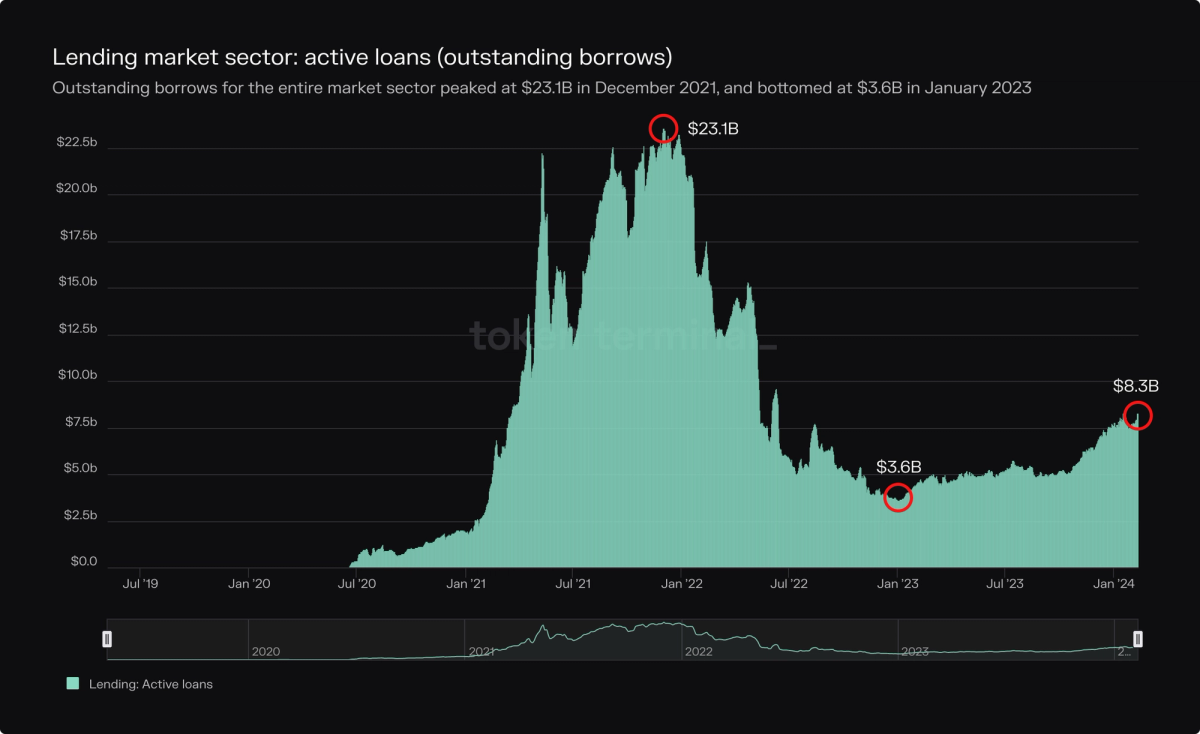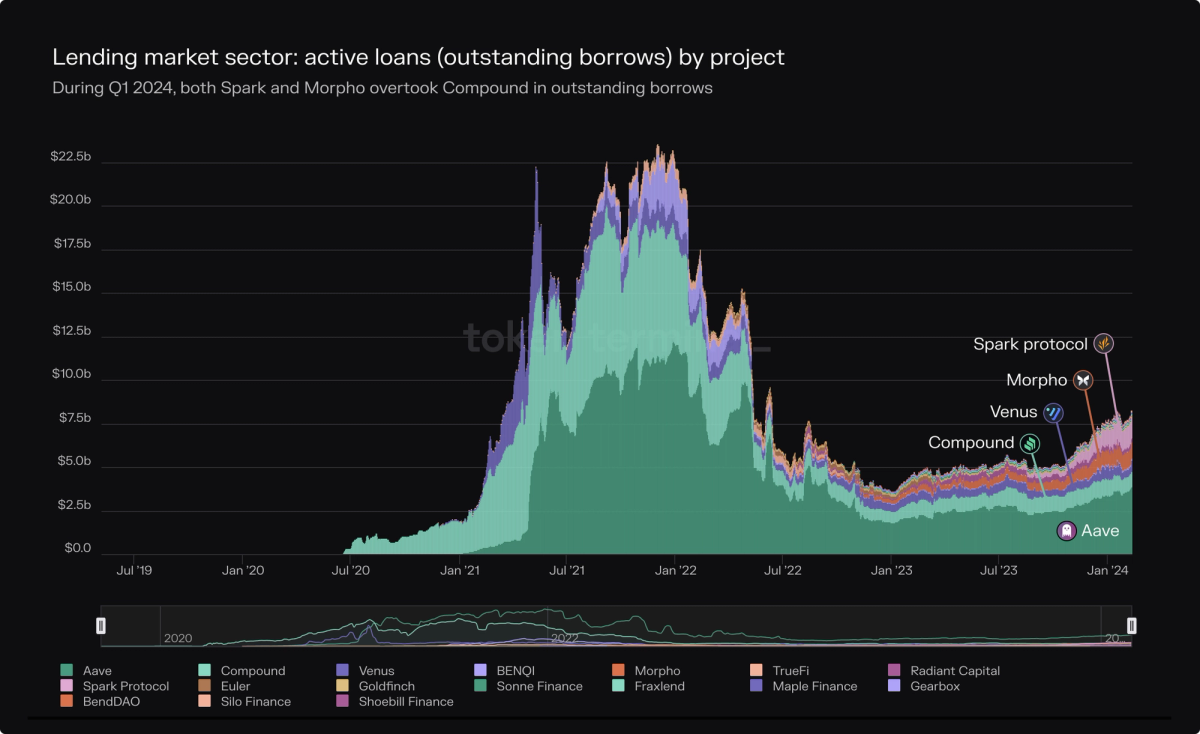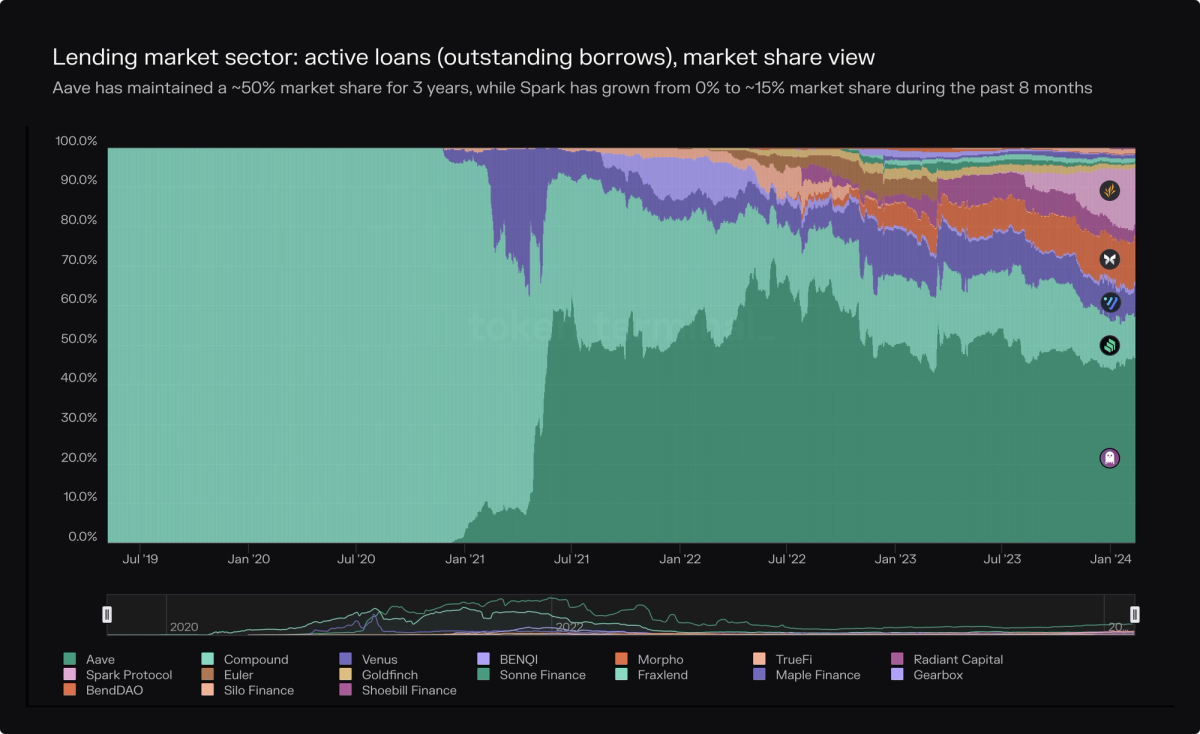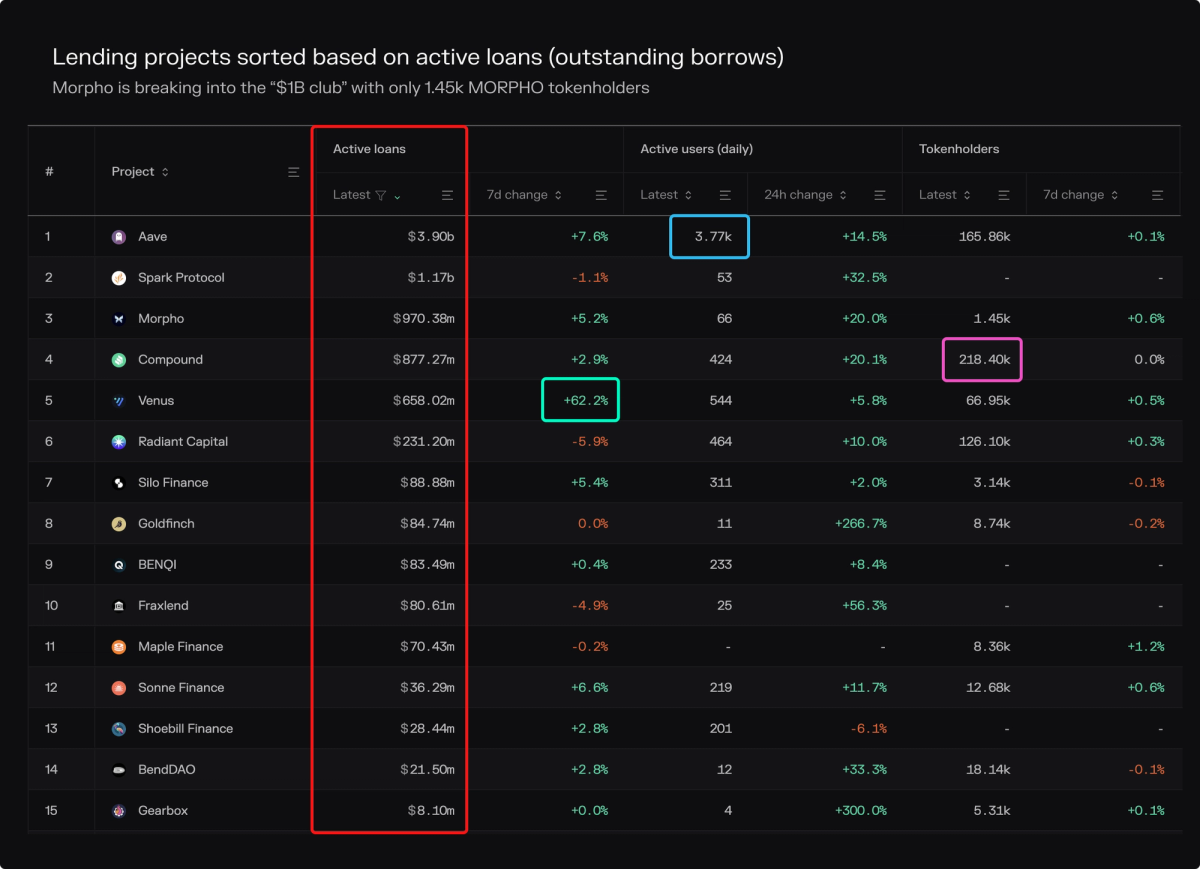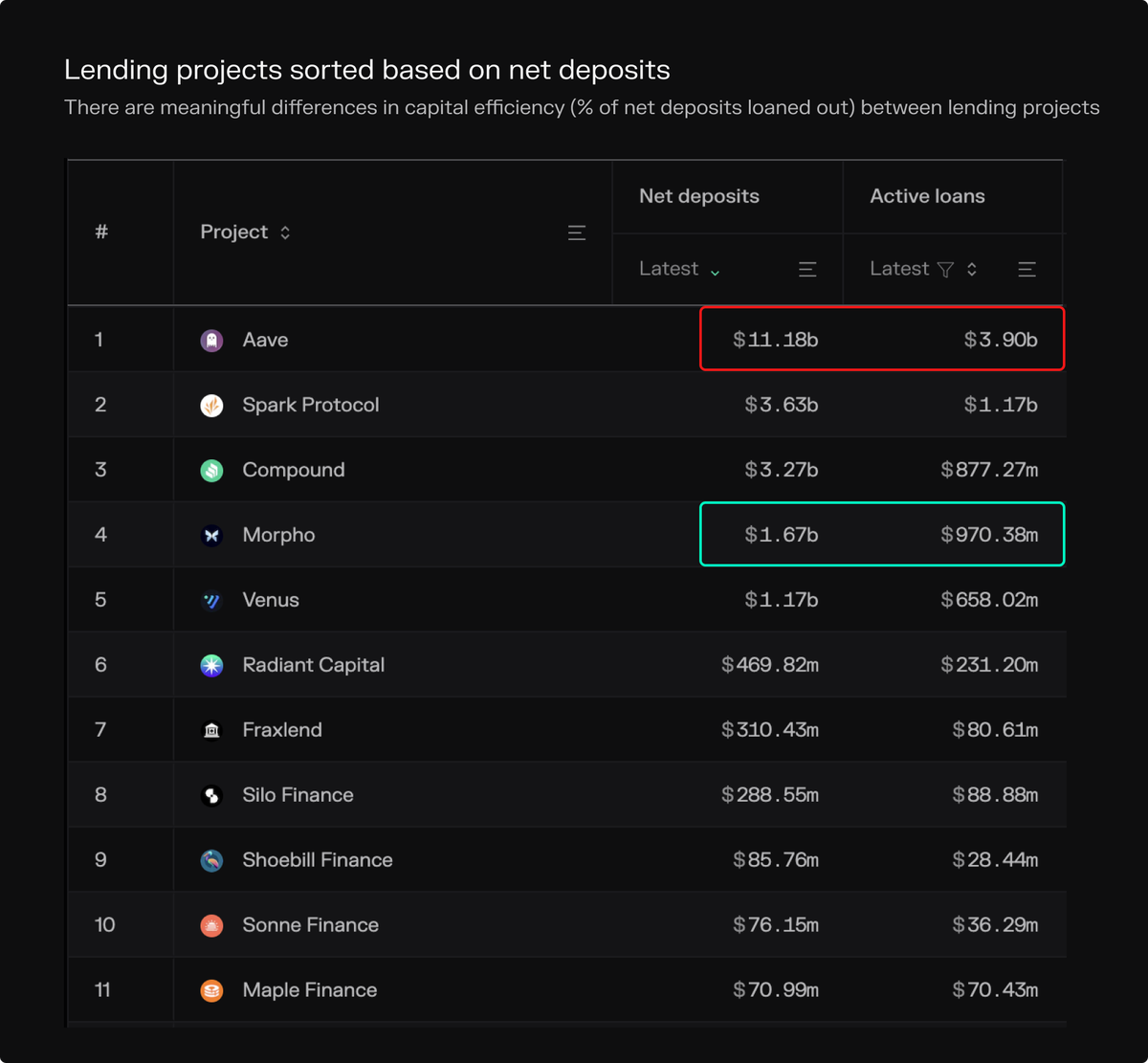- Token Terminal
- Posts
- Weekly fundamentals – Comparing the leading lending protocols
Weekly fundamentals – Comparing the leading lending protocols
Weekly fundamentals — The onchain lending landscape is morphing

Introduction
This week’s newsletter covers the Lending market sector. We zoom out and reflect on how the sector has evolved over the past three years, and highlight a few emerging projects that have grown their market share meaningfully over the past few quarters.
Let’s jump in!
The historical borrowing volume reflects the varying nature of leverage within the DeFi market, with periods of increased borrowing corresponding with bullish market sentiment, and vice versa
The initial growth phase coincided with the launch of the COMP liquidity mining campaign in June 2020. The correlation underscores the impact that token incentive programs can have on market adoption and growth. However, the chart also highlights the sustainability challenges of such programs, as evidenced by the subsequent contraction from the peak in 2021.
Outstanding borrows peaked at $23 billion in December 2021, and bottomed at $3.6 billion in January 2023. The subsequent recovery to $8.3 billion illustrates the market's resilience and potential for future growth.
The integration of real-world assets (RWAs) as collateral, in addition to crypto-native assets, represents a significant opportunity for market expansion.
Contrary to the notion that open-source crypto protocols lack moats, the data indicates that certain protocols, such as Aave, have established significant market dominance. Aave has maintained ~50% market share for three consecutive years, while Compound, another leading DeFi lending protocol, has experienced a decline in its market position over the same period.
Growth strategies in the lending market sector:
“Vampire attack” | Morpho built an aggregator on top of Aave and Compound, to rapidly capture both mind and wallet share in the market, while simultaneously building a new separate protocol of their own called Morpho Blue. |
“Partnership” | Spark taps into the established brand and liquidity of Maker by operating a lending protocol as a subDAO within the broader Maker system. |
“Blue ocean” | Venus has decided to double down on the BNB Chain ecosystem, where many of the “Ethereum-first” lending protocols have yet to establish a strong presence. |
The lending market, similar to traditional financial markets, is governed by power laws, where a small number of players control a large portion of the market.
The entry of new competitors increases competition and innovation, which are likely to lead to faster development of superior products. This heightened competition benefits both application developers building on top of lending protocols, and consumers that interact with these applications.
Benqi's rapid growth in 2021 exemplifies the volatile nature of the DeFi lending market. Despite its initial surge, Benqi (in light purple above) has subsequently shrunk to a smaller role within the market. Further, all projects in the market face risks related to early-stage technology, something that was exemplified by the oracle bug on Euler (in brown above), which resulted in a significant drop in use overnight.
A notable development during Q1 was that both Spark and Morpho surpassed Compound in terms of outstanding loans.
Daily active users (DAUs) are calculated based on user actions such as deposits, borrows, repayments, and withdrawals. The DAU metric does not account for users who passively earn interest or have their assets lent out. One should keep this in mind when analyzing the DAU figures above.
A significant portion of the lending protocol user base may comprise aggregators, such as wallets or other protocols, rather than individual users. This can result in high monetary values, even with low DAU counts.
Venus tends to experience rapid spikes in active loans during BNB Launchpool listings. This suggests that users seek leverage to farm new tokens.
Morpho's approach to user incentivization, involving a non-transferable governance token (MORPHO), allows for user rewards without immediately creating a liquid market for the token. This in contrast to immediately liquid token incentive models, such as Compound's, which tend to attract short-term, opportunistic capital.
Definitions:
Net deposits | User deposits aka money coming into the protocol. |
Active loans | User deposits loaned out to borrowers. |
Total value locked (TVL) | The difference between net deposits and active loans, TVL represents the amount of capital that is currently held within the protocol but not loaned out to borrowers. |
Implications of (high/low) TVL | A high TVL suggests that a considerable portion of the capital within the protocol remains idle. For instance, Aave’s $7 billion in TVL indicates that a large amount of user deposits are not actively loaned out (to generate revenue for the Aave DAO). |
Capital efficiency versus prudent risk management:
Aave's substantial TVL (Net deposits - Active loans) may reflect a more conservative risk management strategy, ensuring that capital is available within the protocol to meet withdrawal demands and mitigate risks.
Morpho's relatively low TVL (Net deposits - Active loans) indicates an approach that leans towards capital efficiency. This approach maximizes the utilization of deposited funds, but may entail higher risk if not managed carefully.
For deeper operational and risk-related insights, one should review the collateral asset breakdowns, collateral ratios, and interest rate mechanisms.
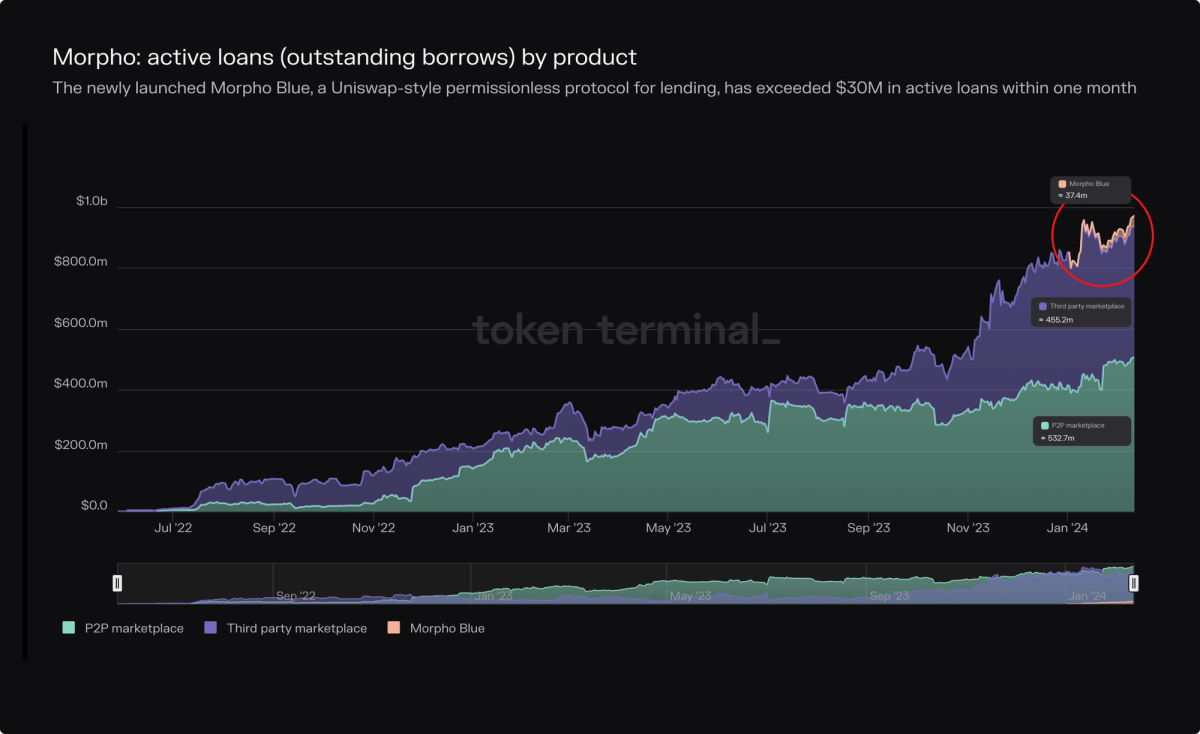
Morpho started with a lending aggregator product, built on top of Aave and Compound, and after reaching ~$1B in deposits, introduced a new separate product called Morpho Blue.
Morpho Blue adopts many of the best practices introduced by Uniswap: permissionless market creation, immutable smart contracts, and a minimalistic code base → a secure and scalable protocol.
For readers, it’s worth keeping an eye on the growth of Morpho Blue, as it could grow into one of the most widely used lending protocols in DeFi.
🤝 The Token Terminal Data Partnership
Are you in charge of 📊Data analytics or 📈Growth/BD at an L1, L2, or appchain's Foundation/Labs?
Regardless of the stage the chain, the Token Terminal Data Partnership™ is a turnkey solution that ensures the availability of a
1) reliable & scalable Data Pipeline,
2)… twitter.com/i/web/status/1…— Token Terminal (@tokenterminal)
8:33 AM • Jan 26, 2024
We're thrilled to partner with @Calderaxyz, the market-leading RaaS platform, to make institutional-grade onchain analytics & standardized reporting available to Caldera Chains!
Interested? Read on!
Are you in charge of 📊Data analytics or 📈Growth/BD at the Foundation/Labs of… twitter.com/i/web/status/1…
— Token Terminal (@tokenterminal)
4:47 PM • Feb 9, 2024
Our mission is to provide technology services to the 8 billion people across the globe. 🌐🚀
— TRON DAO (@trondao)
9:28 PM • Feb 7, 2024
📣 Insights from our community
Data-driven insights from analysts using Token Terminal PRO
This chart from @tokenterminal comparing friendtech's revenue with tvl is pretty telling.
In the absence of points (or tokens), revenue on the platform declined 90% (from $1mil/day to ±$15k) but TVL has declined only about 50% (±$50m to $26mil).
Makes me think users bridged… twitter.com/i/web/status/1…
— Joel John (@joel_john95)
12:08 PM • Feb 8, 2024
How to spot trends and go deeper using onchain data:
1. Start with high-level comparison data: we look at the top blockchains and do relative comparisons across users, revenues, transactions, TVL, DeFi metrics, number of projects etc.
2. Look for trends. In the video, we saw… twitter.com/i/web/status/1…
— Michael Nadeau (@JustDeauIt)
5:26 PM • Feb 11, 2024
We're early in the game, but it's clear: Investing in coins & tokens with economic traction outperforms across the crypto cycle. It boosts investor confidence in protocols with real usage. Our dynamic index strategy ensures we don't hold onto the last cycle's losers.… twitter.com/i/web/status/1…
— Martin Leinweber (@mleinweber2)
8:33 AM • Feb 12, 2024
